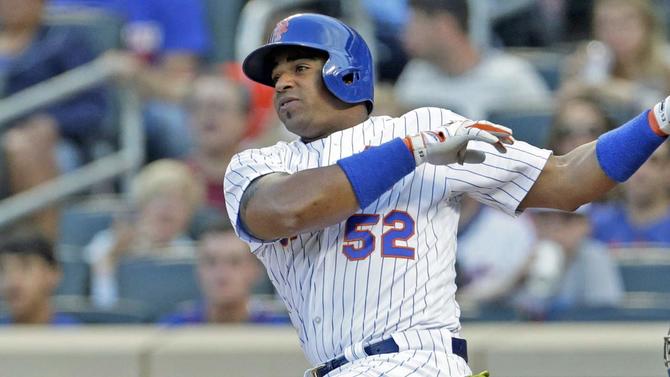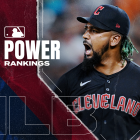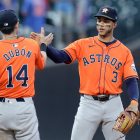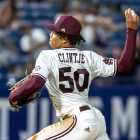SAN DIEGO -- Lo, I come not to bury the Home Run Derby. I enjoy it, particularly under the brisk-in-comparison revised format. Rather, I come to compliment the Home Run Derby, which I just did via the gentlemanly words of the previous sentence, and also to complement the Home Run Derby, which I shall do via the forthcoming Internal Call to Action.
I have come down from Mount Idle Thoughts and present to you on stone tablets the following communiqué: In addition to the Home Run Derby during All-Star week, baseball also needs a Five Tools Derby.
In timeless scouting parlance the "five tools" are the five most fundamental baseball skills for position players: hitting, hitting for power: fielding, throwing, and running. The Home Run Derby, for all its charms, features only one of the five tools. Sure, it's the most conspicuously appealing of the five tools, but it's still only one of them. To celebrate the full complement of tools, why not add an event that calls upon them one and all? Why not indeed! Here's how this scribe envisions the Five Tools Derby going, with bullet-points for today's busy sales professional ...
The set up

- One-on-one-on-one, tournament format. That is, three players compete against each other in each matchup.
- Each contestant in a given round will take one turn hitting/running the bases and two turns in the field. Stated another way, one competing offensive player versus two competing fielders. After the first player batting takes his turn at the plate, he'll take the field, and his opponent, who had been in the field, will get to hit. If, for instance, we have in our Five Tools Derby matchup Mike Trout vs. Jose Altuve vs. Yoenis Cespedes, then it would go a little something like this ... When Trout is at bat, Altuve and Cespedes team up in the field. When it's Altuve's turn to hit, then Trout and Cespedes play defense. When Cespedes is up, Trout and Altuve are patrolling the field.
- Each contestant will select a "batting practice"-level pitcher to throw him hittable, Home Run Derby-style pitches when he's at the plate.
- The Five Tools Derby also features non-competing infielders at each base and a catcher at home plate. Each contestant uses the same infielders.
The competition
- The two competing fielders, positioned wherever they choose, must field the ball regardless of where it's hit.
- The infielders/catcher may not field the ball, even if it goes right to them; they can only field the throw from a competing fielder to apply a force out at first base or a tag out anywhere else. So the two competing fielders are the only players who can field the ball off the bat, and they're charged with covering all of fair territory. As such, pre-pitch positioning is very important and very strategic.
- The pitcher may not field the ball or receive throws.
- One competing fielder retrieves ball (or fields it in the air for an out) and throws it to appropriate base or tags the runner himself. Only the second competing fielder can cut off the ball to make a relay throw.
- The batter runs until he's out, makes it home, or stops at a prior base. He'll receive points for each base gained after first base.
Gameplay, scoring, and additional rules
- The offensive player gets zero points for stopping at first base, second base is worth five points, third base is worth 10 points, and safely touching the plate on a ball in play is worth 20 points. You get just five points for an over-the-fence home run (traditional home runs are worth fewer points so as to encourage balls in play).
- So as to encourage taking extra bases, points on balls in play accumulate. For instance, if the offensive player hits a triple, he gets 15 points: five for reaching second and 10 more for reaching third. If he hits an inside-the-park home run, gets 35 points.
- Points on over-the-fence home runs, however, do not accumulate. They're worth a total of five points, as mentioned.
- If the offensive player is thrown out by the fielder on a tag play, then the offensive player's points for that swing revert to the last base safely reached. For instance, if he's thrown out at third, he gets five points. If he's tagged out before reaching second safely, then he gets no points (as first base does not yield any points).
- The only way a defensive player can earn points is if one of the two defensive players catches a fly ball, line drive or pop-up in the air. If that happens, then each defensive player gets 20 points regardless of which of them makes the catch.
- In the service of reducing risk for injury, offensive players may not slide into a base. Also, no rundowns permitted: once the offensive player crosses the halfway mark between bases, he must continue in the direction of the next base until he's safe or put out. If, before he reaches the halfway mark, he begins returning the prior base, then he may not take the next base unless there's an overthrow.
- The non-competing fielders may not make any throws. Once they've secured the throw from the competing fielder, the offensive player must stop running at the base he's on or the base he's in the process of attempting to reach.
- As mentioned, the offensive player has the option of stopping at a base and concluding that particular "swing." However, the rules are structured so as to incentivize going to the next base (i.e., there's no cost to trying to reach the next base).
- Each hitter gets three swings per "inning" to get as many points as he can. After three swings, the hitter and one of the two fielders swap roles, regardless of whether those swings resulted in balls in play. As such, an offensive player can score no more than 105 points in an inning.
- Foul balls count as a swing and do not result in points for the hitter.
- Taken pitches do not count against the offensive player. Swings-and-misses count as swings unless the player who's leading in the third inning (or extra inning) swings and misses. More on that below.
- Only one bunt allowed per player per inning.
- Each match lasts three innings. The player with the most points advances. In the event of a tie, one extra inning will be played until one player has the most points at the end of a full inning.
- Even if the player batting last leads going into the bottom of the third, he must bat because of the possibility of the fielder scoring points on fly-outs, pop-ups, or line-outs. This is why the offensive player who's leading in the bottom half of the third or extra inning cannot use a swing-and-miss as a swing. Otherwise, he'd swing and miss on purpose so as to eliminate entirely the chance that the fielder could score on a catch.
Gameplay example

Let's go back to that Trout, Altuve, and Cespedes matchup ...
Trout in first: Triple, triple, double for 35 points
Altuve in first: Foul, foul, double for 5 points
Cespedes in first: Triple, foul, triple for 30 points
Trout 35, Cespedes, 10, Altuve 5, end of 1
Trout in second: Tag out at second, traditional home run, triple for 15 points
Altuve in second: Inside-the-park home run, foul, bunt double for 40 points
Cespedes in second: Triple, foul, triple for 30 points
Trout 50, Altuve 45, Cespedes 40, end of 2
Trout in third: Inside-the-park home run, swing and miss, triple for 50 points ...
Altuve in third: Double, double, triple for 25 points
So with Cespedes coming up for the final time, Trout has 100 points, Altuve has 70 points, and Cespedes is at 60. On his first swing, Cespedes bangs one off the left field wall, and it eludes Trout and Altuve long enough for Cespedes to come all the way around for 25 points. It's now Trout 100, Cespedes 85, Altuve 70.
Fearing the bunt, Trout and Altuve confer and then move in closer to first and third, respectively, for the next swing. Cespedes shows bunt but pulls back with Altuve charging and rips one down the left field line. By the time Altuve sprints to the outfield corner and hits Trout with the throw, Cespedes is rounding third. He just beats Trout's throw to the catcher, and Cespedes now leads 110-100 over Trout.
Knowing catching the ball for 20 points is his only hope, Trout moves in just behind the pitcher's mound with Altuve just on the edge of the grass behind shortstop. Cespedes, knowing he's not allowed to swing and miss and have it count as a swing under these circumstances (he's leading in the final inning), just wants to put the ball on the ground and out of reach to secure the win. He also knows he hasn't bunted this inning, so he attempts to lay one down. However, Cespedes jabs at the ball and pops it up. Trout springs quickly and dives, but the ball lands just out of his reach. Cespedes stops at first, thus earning no points, but the win is his.
The thought is that this kind of kind of setup would require bat control, power (to an extent), speed, fielding, and throwing arm -- the five tools. Obviously, only a certain kind of player would be participating in this. The fielder must use his instincts when it comes to pre-pitch positioning, and his speed will obviously come into play, as the ball will rarely be hit directly to him. As for the hitter, bat control is paramount. You want to hit it away from the fielders. Sometimes that means over his head, in front of him, the other way, etc. The hitter must also take aim at these spots without sending the ball foul or swinging and missing (except under the circumstances noted above). It's also about more than just hitting the ball as hard as you can, as hitting the ball over the fence is one of the least valuable outcomes for the hitter. Also, banging it off the wall probably yields fewer bases than sending the ball rolling into the gap.
The bunting wrinkle, of course, adds a bit of a "game theory" element to the competition. The hitter must decide when to use that bunt each time up. Of course, he may not use it at all, as the mere tacit threat of bunting may serve to make the fielders alter their positioning.
Obviously, there's injury risk involved, but that's going to be the case with any baseball activity. It's not hard to imagine an MVP candidate straining an oblique while swinging for the downs in the Home Run Derby, and the All-Star Game is, lest we forget, an actual game of baseball with all its attendant perils.
To me it sounds, like something new and something that puts more of a focus on the fully skilled ballplayer than the Home Run Derby does. Obviously, this is the kind of thing appropriate for only a certain kind of player.
So who ya got in the inaugural Five Tools Derby?


















